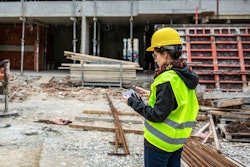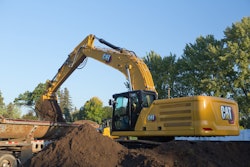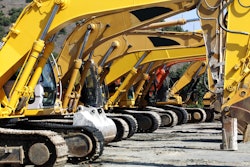
Despite a stack of evidence to the contrary, Associated Builders and Contractors Chief Economist Anirban Basu sees continued room for pessimism in his 2024 economic outlook.
According to his forecast, a recession is forthcoming in very late 2024. Having maintained that pessimistic outlook for the past couple of years, Basu has acknowledged that he’s likely going to be wrong, much like he was in 2023.
“There’s too much momentum for the economy, and until I see the stock market lose some of this value, there is so much wealth flowing in right now, the U.S. economy just cannot have a recession,” he said.
While acknowledging that his projection for 2023 missed the mark and the economy was stronger than he anticipated, he said there has been growing evidence of resurfacing inflationary pressures in the nation’s nonresidential construction segment.
 ABC
ABC
However, maintaining his pessimistic viewpoint, Basu asserts that approximately two-thirds of the growth in nonresidential construction spending resulted from higher prices being charged versus greater output of delivery.
At the crux of any current economic scenario is a determination of when/if the Federal Reserve will initiate any interest rate changes in 2024. A growing number of economists, excluding Basu, suggest there may be no rate changes. That would lead the U.S. into 2025 with high-interest rates, which would likely negatively impact construction and real estate.
Conversely, Basu forecasts up to three rate cuts this year. He noted that monetary policy does not operate immediately; it operates in long and variable lags. His theory is that the full impact of the higher interest rates has not yet fully permeated the U.S. economy.
The high-interest rates currently seen around the world are a byproduct of the high rate of inflation that was unleashed in early 2021 when demand for goods and services came surging out of the pandemic.
He maintains the Federal Reserve missed the chance to halt excess inflation when it first got underway in 2021, subsequently setting off a labor cost spiral that has yet to subside or show up in most inflation data. It was not until 2022 that interest rates started to rise to combat inflation, which until that point was labeled as being transitory or fleeting.
“We are a deeply indebted society currently facing high borrowing costs and that's what makes me pessimistic regarding the near-term outlook,” Basu said, noting that the Federal Reserve is limited in its actions with inflation remaining above the 2% goal.
Much of the data he has analyzed continues to show ongoing economic momentum. However, he points to the ongoing geopolitical pressures and the coming federal elections as indicators that will not be beneficial.
Supply chains as a general proposition are still far more dependable than they were late 2021.
“What we get as supply chains improve, in the context of unmet demand, is a lot of transactional volume, that's economic growth and that's exactly what we've seen in the last couple of years,” Basu said.
Looking ahead a new set of supply chain issues is emerging, including the cost of insuring ships and bottlenecks in the Red Sea, the Panama Canal, and Baltimore.
“This is not especially good news for those who purchase construction services,” said Basu. “In addition to supply chain issues, there is an abundance of publicly and privately financed megaprojects around the nation, massively increasing demand for certain inputs.”
Overall, he said the level of concern regarding the demand for consulting services and the availability of financing for projects is up.
“The notion that interest rates will remain higher for longer remains firmly in place, which means that project financing costs will likely be an ongoing issue for construction demand, especially in privately financed segments, for the foreseeable future,” he said.
 ABC
ABC
Broad perspective
On a larger scale, the consumer remains the leading engine of economic growth.
Since the start of the pandemic, Basu said consumer spending has continued to rise dramatically, at rates far higher than the Fed’s suggested general rate of 2% inflation.
“It suggests that consumers, the leading engine of economic growth, cannot continue to spend the way they havebeen,” Basu said. “That suggests maybe no recession, but some economic slowdown going forward.”
The snapshot is then of an economic slowdown, with high inflation and high-interest rates.
“It's not a great combination,” he said.
From that perspective, Basu returns to the concern about interest rates.
To maintain a particular lifestyle or even to move forward, more consumers are finding their way into credit card delinquency. To compensate, credit interest rates have increased.
Basu believes this will ultimately lead to consumers taking on less credit card debt as more credit card issuers are saying no to the next credit card application and more banks are tightening their standards for credit card issuance.
As credit options are reduced, some consumers are running out of flexibility, even digging back to their 401 K plans to make ends meet.
“That can stimulate spending in the short term, but you can imagine at least some unsustainability as well,” Basu said.
Contractor’s view
According to ABC’s Construction Confidence Index and other recent polls, most contractors have a more optimistic view of 2024. Firms are projecting increased sales, staffing levels, and profit margins over the next six months.
“The cost of doing constructing services and wages are way up and yet there is enough demand out there that many of you believe you can drive your profit margins still higher over the next six months,” Basu said.
Wage increases and material price fluctuations are expected to continue to impact that confidence.
Meanwhile, for firms in public construction, Basu admits that almost none of his forecasts is relevant due to the amount of federal funding available for infrastructure and education projects. A substantial amount of those funds have been programmed and must be spent by 2026.
As an election year, construction firms will take an interest in the next presidential administration. The current administration seems to favor more work from union-based contractors versus merit-based shops.
“That makes a difference clearly in terms of market share, and the cost-of-living infrastructure work, he said. “Overall, there's going to be a lot of public money flowing through the economy for the next five, six years.”
 ABC
ABC












